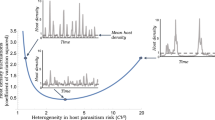Abstract
A discrete-time host-parasitoid model including host-density dependence and a generalized Thompson escape function is analyzed. This model assumes that parasitoids are egg-limited but not search-limited, and is proven to exhibit five types of dynamics: host failure in which the host goes extinct in the parasitoid's presence or absence, unconditional parasitoid failure in which the parasitoid always goes extinct while the host persists, conditional parasitoid failure in the host and the parasitoid go extinct or coexist depending on the initial host-parasitoid ratio, parasitoid driven extinction in which the parasitoid invariably drives the host to extinction, and coexistence in which the host and parasitoid coexist about a global attractor. The latter two dynamics only occur when the parasitoid's maximal rate of growth exceeds the host's maximal rate of growth. Moreover, coexistence requires parasitism events to be sufficiently aggregated. Small additive noise is proven to alter the dynamical outcomes in two ways. The addition of noise to parasitoid driven extinction results in random outbreaks of the host and parasitoid with varying intensity. Additive noise converts conditional parasitoid failure to unconditional parasitoid failure. Implications for classical biological control are discussed.
Similar content being viewed by others
References
Arditi, R., Berryman, A.A.: The biological control paradox. Trends in Ecology and Evolution 6, 32 (1991)
Arditi, R., Ginsberg, L.R.: Coupling in predator-prey dynamics: ratio-dependence. J. Theoretical Biol. 139, 311–326 (1989)
Beddington, J.R., Free, C.A., Lawton, J.H.: Dynamic complexity in predator-prey models framed in difference equations. Nature 225, 58–60 (1975)
Berezovskaya, F., Karev, G., Arditi, R.: Parametric analysis of the ratio-dependent predator-prey model. J. Math. Biol. 43 (3), 221–246 (2001) MR 2002i:92019
Comins, H.N., Wellings, P.W.: Density-related parasitoid sex-ratio: influence on host-parasitoid dynamics. J. Anim. Ecol. 54, 583–594 (1985)
de Melo, W., van Strien, S.: One dimensional dynamics. Springer-Verlag, Berlin, 1993
Durrett, R.: Probability: theory and examples. Duxbury Press, Belmont, CA, 1996. MR 98m:60001
Getz, W.M.: Population dynamics: a per-capita resource approach. J. Theoret. Biol. 108, 623–643 (1984)
Getz, W.M.: A hypothesis regarding the abruptness of density dependence and the growth rate of populations. Ecology 77, 2014–2026 (1996)
Getz, W.M., Mills, N.J.: Host-parasitoid coexistence and egg-limited encounter rates. Am. Nat. 148, 333–347 (1996)
Gutierrez, A.P.: The physiological basis of ratio-dependent predator-prey theory: a metabolic pool model of nicholson's blowfies as an example 73, 1552–1563 (1992)
Gutierrez, A.P., Mills, N.J., Schreiber, S.J., Ellis, C.K.: A phsysiologically based tritrophic perspective on bottom-up top-down regulation of populations. Ecology 75, 2227–2242 (1994)
Hassell, M.P.: The dynamics of arthropod predator-prey systems. Monographs in Population Biology, vol. 13, Princeton University Press, Princeton, N.J., 1978. MR 80d:92026
Hastings, A.
Hochberg, M.E., Holt, R.D.: Refuge evolution and the population dynamics of coupled host-parasitoid associations. Evolutionary Ecology 9, 633–661 (1995)
Hsu, S.-B., Hwang, T.-W., Kuang, Y.: Global analysis of the Michaelis-Menten-type ratio-dependent predator-prey system. J. Math. Biol. 42 (6), 489–506 (2001). MR 2002f:92020
Hsu, S.-B., Li, M.-C., Liu, W., Malkin, M.: Heteroclinic foliation, global oscillations for the Nicholson-Bailey model and delay of stability loss. Discrete Contin. Dyn. Syst. 9 (6), 1465–1492 (2003). MR 2 017 677
Kifer, Y.: Random perturbations of dynamical systems. Progress in Probability and Statistics, vol. 16, Birkhäuser Boston Inc., Boston, MA, 1988. MR 91e:58159
Kuang, Y., Beretta, E.: Global qualitative analysis of a ratio-dependent predator-prey system. J. Math. Biol. 36 (4), 389–406 (1998). MR 99i:92022
Lane, S.D., Mills, N.J., Getz, W.M.: The effects of parasitoid fecundity and host taxon on the biological control of insect pests: the relationship between theory and data. Ecological Entomology 24, 181–190 (1999)
Luck, R.F.: Evaluation of natural enemies for biological control: a behavior approach. Trends in Ecology and Evolution
May, R.M.: Host-parasitoid systems in patch environments: a phenomenological model. J. Anim. Ecol. 47, 833–843 (1978)
May, R.M., Hassell, M.P., Anderson, R.M., Tonkyn, D.W.: Density dependence in host-parasitoid models. J. Animal Ecol. 50, 855–865 (1981)
Nicholson, A.J., Bailey, V.A.: The balance of animal populations. Proc. Zool. Soc. Lond. 1935, pp. 551–598
Ricker, W.E.: Stock and recruitment. J. Fish. Res. Board. Can. 11, 559–623 (1954)
Rogers, D.J.: Random search and insect population models. J. Animal Ecol. 41, 369–383 (1972)
Ruelle, D.: Small random perturbations of dynamical systems and the definition of attractors. Commum. Math. Phys. 82 (1), 137–151 (1981/82). MR 83c:58051
Schreiber, S.J., Fox, L.R., Getz, W.M.: Coevolution of contrary choices in host-parasitoid systems. Am. Nat., 2001, pp. 637–648
Schreiber, S.J., Fox, L.R., Getz, W.M.: Parasitoid sex allocation affects coevolution of patch selection in host-parasitoid systems. Evolutionary Ecology Research 4, 701–718 (2002)
Thompson, W.R. La theory mathematique de l'action des parasites entomophages et le facteur du hassard. Annales Faculte des Sciences de Marseille 2, 69–89 (1924)
van Baalen, M., Sabelis, M.W.: Coevolution of patch selection strategies of predator and prey and the consequences for ecological stability. Am. Nat. 142, 646–670 (1993)
Wang, Y.H., Gutierrez, A.P.: An assessment of the use of stability analyses in population ecology. J. Animal Ecology 49 (2), 435–452 (1980). MR 82g:92057
Xiao, D., Ruan, S.: Global dynamics of a ratio-dependent predator-prey system. J. Math. Biol. 43 (3), 268–290 (2001). MR 2002i:92025
Author information
Authors and Affiliations
Corresponding author
Rights and permissions
About this article
Cite this article
Schreiber, S. Host-parasitoid dynamics of a generalized Thompson model. J. Math. Biol. 52, 719–732 (2006). https://doi.org/10.1007/s00285-005-0346-2
Received:
Published:
Issue Date:
DOI: https://doi.org/10.1007/s00285-005-0346-2




